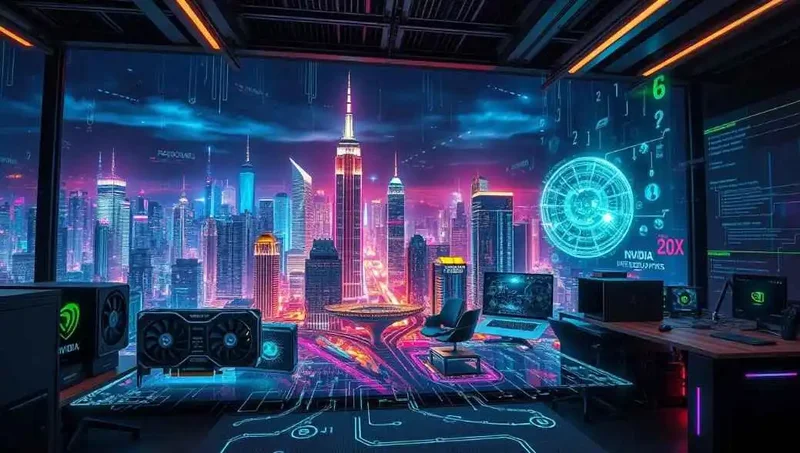Real-Time BNB Signal Analytics
Real-Time BNB Signal Analytics
When I saw the headline about NVIDIA hitting a $5 trillion valuation, I honestly just leaned back in my chair. Not in shock, but with a sense of profound affirmation. For years, we’ve talked about the AI revolution in terms of apps, chatbots, and stock prices. But I’ve always believed that was just the surface noise. The real story, the one that’s been building quietly behind the scenes, is infinitely bigger.
That $5 trillion figure isn’t just a market milestone; it’s a receipt. It’s the proof of purchase for a new kind of world-building, a transition as fundamental as the shift from agrarian societies to industrial nations. We’re not just watching a company get rich. We’re watching the birth of an entirely new asset class for civilization: manufactured intelligence.
And if you want to know where the first bricks of this new world were laid, you have to look at what happened in South Korea. It was the blueprint.
Forget what you think you know about factories—the clang of metal, the smell of oil, the assembly lines churning out cars and chips. A new kind of factory is being built, and its primary output is thought itself. Last year, when NVIDIA announced its sweeping partnership with South Korea, it wasn't just a tech deal; it was a declaration of a new national identity.
The scale of it was, and still is, mind-boggling. Over a quarter-million of NVIDIA’s most advanced GPUs earmarked for a single country. This isn't just about giving researchers faster computers. This is the dawn of what we call 'Sovereign AI'—in simpler terms, it's a nation's ability to generate its own world-class intelligence, on its own terms, using its own data and culture. It’s a nation deciding it will no longer just import intelligence from Silicon Valley; it will produce its own.
Imagine the sheer physical reality of it. Data centers stretching across the landscape, humming with a power that’s both electrical and cognitive. This is a coordinated, national effort on a scale we haven't seen since the space race. You have the Korean government, Samsung, Hyundai Motor Group, SK Group, NAVER—all the titans of the country's industrial miracle—investing billions to build these "AI Factories." Hyundai isn't just using AI to design cars anymore; it’s building the infrastructure to invent entirely new forms of mobility. Samsung isn't just making better chips; it's using digital twins in the NVIDIA Omniverse to simulate and perfect its manufacturing processes before a single physical tool is moved.

This is the kind of breakthrough that reminds me why I got into this field in the first place. It’s a shift from atoms to bits as the primary driver of national power. What happens when a nation's most valuable export is no longer cars or ships, but pure, unadulterated intelligence? South Korea is placing a multi-billion dollar bet on becoming the first to find out.
So how do we get from a massive GPU deployment in Korea to a $5 trillion valuation on Wall Street? You have to understand the feedback loop that was created. NVIDIA isn't just selling shovels in a gold rush. It's selling the blueprints and the machinery for entire, self-sustaining gold-mining ecosystems. This creates a virtuous cycle where better chips allow for bigger models which create new industries that demand more chips and the whole thing just accelerates at a pace that feels less like a straight line and more like an exponential explosion of capability.
Of course, the skeptics see this differently. I read a quote from an analyst who warned, “The moment investors start demanding cash-flow returns instead of capacity announcements, some of these flywheels could seize.” With all due respect, that’s like looking at the construction of the US Interstate Highway System in the 1950s and asking what the quarterly return on a mile of asphalt is. It completely misses the point.
The value isn’t in the infrastructure itself; it’s in everything the infrastructure makes possible. The highway system didn’t generate profit directly, but it unlocked trillions of dollars in commerce, logistics, and suburban development. These AI Factories are our generation's cognitive highways. The "cash-flow returns" won't come from the data centers; they'll come from the medical breakthroughs, the scientific discoveries, the autonomous logistics networks, and the creative industries that this sovereign intelligence will unleash.
This is a paradigm shift, and it comes with profound responsibilities. The race to build sovereign AI could easily become the 21st century's version of the nuclear arms race—a frantic scramble for cognitive supremacy with unforeseen consequences. We have to ensure that as we build these powerful national "brains," we also instill them with our best values: transparency, collaboration, and a deep-seated focus on human well-being. The power to create national-scale intelligence is the power to solve national-scale problems. Or create them. The choice is still very much ours.
That $5 trillion number is a ghost. It's a shadow cast on the wall of the stock market by something much more real and substantial that's happening in the world. We’re fixated on the valuation because it's a simple, digestible metric, but it's not the real story.
The real story is that for the first time in history, a nation's potential is no longer solely defined by its natural resources, its manufacturing base, or its financial capital. It is now defined by its computational capacity—its ability to learn, reason, and create at a scale beyond human cognition. NVIDIA’s stock price is just a crude barometer for this tectonic shift. The true wealth being created isn't financial; it's intellectual. And it's being built, right now, one GPU at a time.